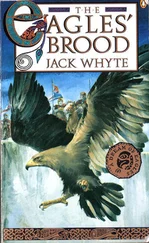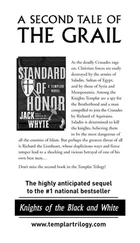He reined in now, with barely more than his own height between him and the top, and bent forward in the saddle, gentling his horse with the flat of his hand against its neck until it regained its normal breathing speed. He dismounted and led both animals, one at a time, across what proved to be a very narrow, steeply sloping, and treacherous strip of ground that fell away into the deep ravine that edged the ridge, then remounted and made his way to the shoulder of ground ahead of him that masked his view of the valley below. The hillside ahead of him swept down gently for a hundred paces or so, then rose upward again to another, lower ridge, beyond which he could see nothing but sky. He prodded his horse forward gently to the other slope, and this time as he approached the crest he became aware of a sound, strange and unrecognizable, rising and falling in the distance. Curious, he spurred his horse more urgently, and it surged up to the top of the second ridge to show him a sight that took his breath away and left him staring open mouthed at the scene below him, with not a thought in his head of being seen.
A battle was being fought in the valley bottom, but even as he looked at it for the first time, trying to absorb the scope of it, he could see that there was something fundamentally lopsided about it. It took several moments for him to adjust to the new perspective, for now he was looking down from what felt like an immense height and everything appeared strange and different. Nevertheless, within a few moments he saw what it was, and understanding came to him in a flash, although it was a flash of disappointment. With a rising surge of disbelief he saw that Richard Plantagenet had blundered, for the first time in a lifetime of warfare.
It was clear that the Muslim troop movements he had identified that morning, with hundreds of riders moving far up on the high wooded slopes, had featured prominently in Saladin’s attack, and that the first attack had come from there.
The Frankish army stood directly below St. Clair with their backs to the sea, and from where he sat he could not believe the closeness with which they were all jammed together, or the savagery with which Saladin’s forces were attacking them from above, shooting arrows and crossbow bolts into the densely packed mass as quickly as they could launch and reload. So thick was the press down there that no aim was required from the heights above. Every missile fired, no matter how carelessly, found a target, and the raised shields of the Frankish knights formed a kind of roof against the downpour.
To St. Clair’s right, the straight and narrow Roman road stretched back to the ground beside the swamp where Richard’s army had spent the night, and he could see that it lay open, with no signs of trap or ambush to deter the Franks from retreating in that direction. On the other side, however, to the south, the roadway vanished into a tunnel of trees about half a mile from where the Franks had stopped their advance, and there were sufficient bodies, both human and equine, on the surface of the road to demonstrate that the Muslims had attacked from there, sweeping out of the tunnel and down through the woods above the road to stop Richard’s army in its tracks.
Everything looked small and compact from where he sat, but André St. Clair knew that the Frankish host that looked so strangely small and cramped from his viewpoint was the largest foreign army ever assembled here since Roman times, and it was surrounded on three sides by a force that greatly outnumbered it. So closely were the Frankish troops packed that certain of the various contingents appeared as solid blocks of color, the most noticeable of those being the redflecked white mass of the Templars on St. Clair’s left, holding the vanguard which had now become the right of the line, and the solid, black-garbed mass of the Hospitallers of the rearguard, now forming the left of the line. Between those were the blue and gold of the French knights, but it was the military orders of the Temple and the Hospital who stood out most significantly in the solid phalanges of color.
Richard had insisted from the outset of this drive from Acre to Jerusalem that he would not commit the same errors that had doomed his predecessors in their misadventures with Saladin. He had great respect for the Kurdish Sultan and he was determined that he would make no foolish or impulsive errors with his command that would present the Saracen leader with any undue advantage, and in Richard’s eyes the greatest and most consistent weakness that the Frankish armies had demonstrated within recent years was their tendency to charge headlong against the enemy and consider the costs afterwards, when the appalling price had been paid and tallied. Richard was under no illusions about those tactics and their origins. They sprang directly from the stubborn, headstrong arrogance of the Templars and the Hospitallers, who simply refused to believe that there might ever be a circumstance in which they, with God so firmly on their side and in their prayers at all times, should even hesitate to engage the enemy tooth and nail. That the enemy knew exactly how to provoke those charges, and then how to avoid them and wreak havoc on the suicidal Christians as they charged past, appeared to have no significance to the senior field commanders of either Order. Their quest was for glory—their own personal glory first, and the greater glory of God incidentally.
Richard had been determined to curb that zeal, and had kept all of his subordinates on a tight leash. He had been fighting ruthless, determined, and ambitious enemies throughout his life, beginning in his boyhood, and there had been none of them whom he respected more than Saladin. And so he had insisted on a slow, steady progress from the moment he left Acre, keeping his knights tightly in check, in compact defensive formations that were, he believed, invulnerable to Muslim attack.
Now, however, from where St. Clair watched, it appeared that the King had held them in too tightly, for his cavalry forces were so densely compressed that they had no room to maneuver or even to regroup. Hemmed in on every side by their own infantry formations and under constant missile assault from the slopes above, they had no other option than to sit massed together, with the ground falling away at their backs towards the sea, and wait to be chopped down. Their armor was the finest in the world, and it rendered them all but invulnerable, but there were always weak spots in armor and accidental exposures to what was an incessant hail of arrows.
Then, even as he watched, St. Clair saw another phase of the attack develop as a solid phalanx of the black-clad desert nomads called Bedouin—he quickly estimated at least half a thousand—charged down from concealed positions high in the woods and launched a ferocious attack on the tightly compressed forces of the Hospitallers of the rearguard, on the far left of the Frankish line. Incredulous, St. Clair watched as the Hospital knights were squeezed even more tightly, something he would not have believed possible by that stage, and the protective lines of infantry fronting their formations swayed and buckled.
“Charge them! Break out, or you’re all dead men!” He was shouting at the top of his voice, bellowing advice down to the beleaguered men who could neither hear nor see him, but even as he hurled down imprecations and exhortation, he could see that nothing was to be done. The scene was set for a bloodbath. The front line of the Bedouin charge approached the farthest edge of the rearguard formations and then the riders drew rein and leapt from their horses to charge in a solid block towards what they must have identified, for reasons of their own, as the weakest part of the opposing front. St. Clair could visualize their dark, feral faces as they swept forward, brandishing their fearsome scimitars. Of all the warriors of the Faithful, the Franks disliked and feared the Bedouin above all others.
Читать дальше







